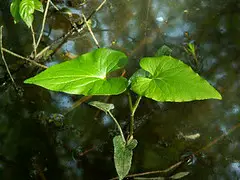The Arrowhead Plant, known for its unique arrow-shaped leaves, is a diverse and attractive option for indoor and outdoor gardening. Its vibrant colors and intriguing leaf structures can add a touch of exotic flair to any space. As the plant matures, its leaves change shape, offering a dynamic appearance that evolves over time.
Native to a wide range of countries in Latin America, the Arrowhead Plant thrives in warm, humid conditions. It’s adaptable to various growing conditions and is often celebrated for its ease of care, making it a popular choice for novice and experienced gardeners alike.
The Arrowhead Plant belongs to the Syngonium genus and comes in various species and cultivars. Its beautiful shades of green, pink, white, and yellow can be chosen to fit different aesthetic preferences, and it’s often used in decorative displays, hanging baskets, or as a climbing plant with the support of a moss pole.
| Attribute | Details |
|---|---|
| Common Names | Arrowhead Plant, Goosefoot |
| Botanical Name | Syngonium podophyllum |
| Family | Araceae |
| Plant Type | Perennial Climbing Plant |
| Mature Size | 2-3 feet (indoors) |
| Sun Exposure | Low to Medium Light |
| Soil Type | Well-draining Potting Mix |
| Hardiness Zones | 10-12 |
| Native Area | Latin America |
Arrowhead Plant Care
The care of the Arrowhead Plant, or Syngonium podophyllum, is relatively straightforward, especially when its natural tropical habitat is considered. Keeping the soil consistently moist and providing proper light, as well as occasional feeding and pruning, will result in a lush, thriving plant.
A popular houseplant, the Arrowhead Plant can be maintained with minimal fuss. Regular inspection for pests and diseases, combined with the appropriate care routine, ensures that this eye-catching plant remains healthy and vibrant.
Light Requirement for Arrowhead Plant
Arrowhead Plants grow best in low to medium light, thriving in filtered or indirect sunlight. Direct sun can cause the leaves to scorch, so it’s advisable to place the plant in a shaded spot or behind a curtain to diffuse the sunlight.
Soil Requirements for Arrowhead Plant
A well-draining potting mix with peat moss and perlite will suit the Arrowhead Plant perfectly. The soil should retain moisture but not become waterlogged, providing the right balance for this tropical beauty.
Water Requirements for Arrowhead Plant
Watering should be consistent, keeping the soil evenly moist without allowing it to become soggy. Reducing watering during the winter months and ensuring that the pot has proper drainage will support optimal growth.
Temperature and Humidity
Arrowhead Plants prefer a warm, humid environment. A temperature range of 60-75°F (16-24°C) and maintaining high humidity through misting or using a humidifier will replicate the plant’s native tropical conditions.
Fertilizer
Feeding the Arrowhead Plant with a balanced, liquid houseplant fertilizer every 4-6 weeks during the growing season will promote vibrant growth. Over-fertilizing should be avoided to prevent damage to the plant.
Pruning Arrowhead Plant
Regular pruning helps maintain the shape of the Arrowhead Plant and encourages fuller growth. Removing dead or yellowing leaves and occasional trimming will keep the plant looking its best.
Propagating Arrowhead Plant
Arrowhead Plants are easily propagated through stem cuttings. A cutting with at least two nodes can be placed in water or soil, where it will develop roots and grow into a new plant.
How To Grow Arrowhead Plant From Seed
Growing from seed is possible but more challenging and time-consuming. Sowing fresh seeds in a well-draining mix and maintaining consistent warmth and humidity can lead to successful germination.
Common Pests & Plant Diseases
Aphids
Aphids can be treated with insecticidal soap or neem oil.
Root Rot
Root rot can be avoided with proper watering habits and good soil drainage.
Common Problems With Arrowhead Plant
Yellowing Leaves
This may indicate overwatering and can be resolved by adjusting watering practices.
Leggy Growth
Insufficient light can cause leggy growth. Moving the plant to a brighter location can correct this issue.
Pro Tips
- Avoid direct sunlight to prevent leaf scorching.
- Maintain consistent watering without overwatering.
- Provide a warm, humid environment.
- Regularly inspect for pests and diseases.
- Prune as needed to maintain the desired shape.

